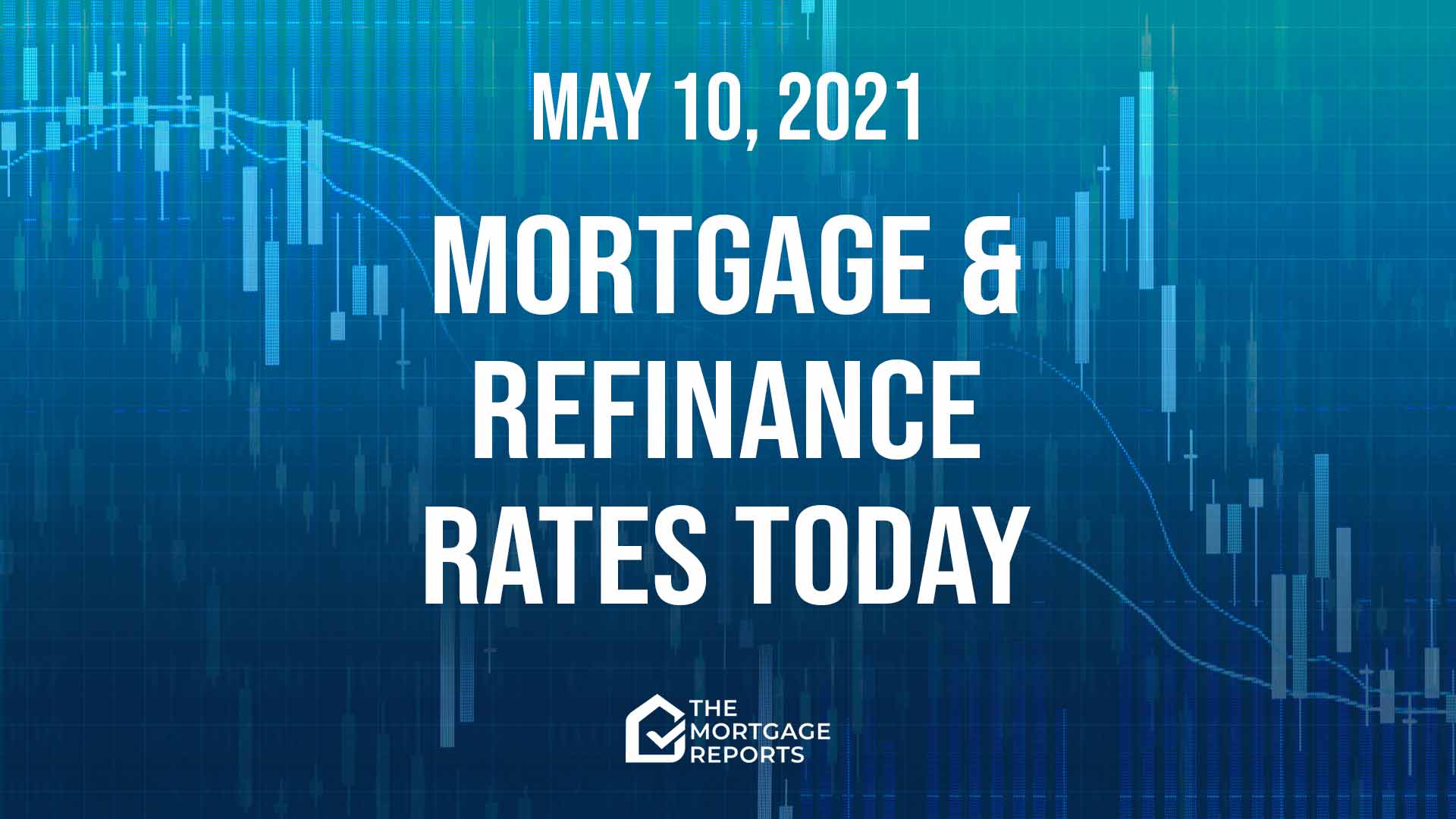
Today’s mortgage and refinance rates
Average mortgage rates fell appreciably last Friday. The drop was a result of that morning’s disappointing jobs report.
And, first thing, market movements suggested that mortgage rates today might hold steady or just inch either side of the neutral line. But read on for reasons why those rates could bounce back later today or very soon.
Find and lock a low rate (May 10th, 2021)Current mortgage and refinance rates
| Program | Mortgage Rate | APR* | Change |
|---|---|---|---|
| Conventional 30 year fixed | |||
| Conventional 30 year fixed | 2.978% | 2.983% | Unchanged |
| Conventional 15 year fixed | |||
| Conventional 15 year fixed | 2.188% | 2.305% | Unchanged |
| Conventional 20 year fixed | |||
| Conventional 20 year fixed | 2.75% | 2.842% | Unchanged |
| Conventional 10 year fixed | |||
| Conventional 10 year fixed | 1.815% | 1.979% | -0.03% |
| 30 year fixed FHA | |||
| 30 year fixed FHA | 2.691% | 3.347% | Unchanged |
| 15 year fixed FHA | |||
| 15 year fixed FHA | 2.451% | 3.052% | +0.11% |
| 5 year ARM FHA | |||
| 5 year ARM FHA | 2.5% | 3.194% | -0.01% |
| 30 year fixed VA | |||
| 30 year fixed VA | 2.348% | 2.52% | +0.09% |
| 15 year fixed VA | |||
| 15 year fixed VA | 2.25% | 2.571% | Unchanged |
| 5 year ARM VA | |||
| 5 year ARM VA | 2.5% | 2.372% | -0.01% |
| Rates are provided by our partner network, and may not reflect the market. Your rate might be different. Click here for a personalized rate quote. See our rate assumptions here. | |||
COVID-19 mortgage updates: Mortgage lenders are changing rates and rules due to COVID-19. To see the latest on how coronavirus could impact your home loan, click here.
Should you lock a mortgage rate today?
I would lock today if I were you. Last Friday, pretty much all markets initially reacted as you’d expect to that morning’s bad employment situation report. But nearly all of them bounced back during that afternoon. Of the ones we care about most, only mortgage rates retained their early fall.
Of course, it’s possible that they’ll stay low. But it’s at least as likely that they’ll rebound today (or soon) to put them back in line with other assets.
Choosing when to lock your rate is always a matter of weighing perceived risks and rewards. So only you can decide what to do next. But my personal rate lock recommendations remain:
- LOCK if closing in 7 days
- LOCK if closing in 15 days
- LOCK if closing in 30 days
- LOCK if closing in 45 days
- LOCK if closing in 60 days
But I don’t claim perfect foresight. And your personal analysis could turn out to be as good as mine — or better. So you might choose to be guided by your instincts and your personal tolerance for risk.
Market data affecting today’s mortgage rates
Here’s a snapshot of the state of play this morning at about 9:50 a.m. (ET). The data, compared with roughly the same time last Friday, were:
- The yield on 10-year Treasurys rose to 1.57% from 1.54% (Bad for mortgage rates.) More than any other market, mortgage rates normally tend to follow these particular Treasury bond yields, though less so recently
- Major stock indexes were mixed on opening. (Neutral for mortgage rates.) When investors are buying shares they’re often selling bonds, which pushes prices of those down and increases yields and mortgage rates. The opposite happens when indexes are lower
- Oil prices increased to $64.96 from $64.69 a barrel. (Neutral for mortgage rates*.) Energy prices play a large role in creating inflation and also point to future economic activity.
- Gold prices edged up to $1,844 from $1,832 an ounce. (Neutral for mortgage rates*.) In general, it’s better for rates when gold rises, and worse when gold falls. Gold tends to rise when investors worry about the economy. And worried investors tend to push rates lower
- CNN Business Fear & Greed index — Rose to 58 from 51 out of 100. (Bad for mortgage rates.) “Greedy” investors push bond prices down (and interest rates up) as they leave the bond market and move into stocks, while “fearful” investors do the opposite. So lower readings are better than higher ones
Caveats about markets and rates
Before the pandemic and the Federal Reserve’s interventions in the mortgage market, you could look at the above figures and make a pretty good guess about what would happen to mortgage rates that day. But that’s no longer the case. We still make daily calls. And are usually right. But our record for accuracy won’t achieve its former high levels until things settle down.
So use markets only as a rough guide. Because they have to be exceptionally strong or weak to rely on them. But, with that caveat, so far mortgage rates today look likely to hold steady or edge downward. But read the warnings above. And be aware that intraday swings (when rates change direction during the day) are a common feature right now.
Find and lock a low rate (May 10th, 2021)
Important notes on today’s mortgage rates
Here are some things you need to know:
- Typically, mortgage rates go up when the economy’s doing well and down when it’s in trouble. But there are exceptions. Read ‘How mortgage rates are determined and why you should care
- Only “top-tier” borrowers (with stellar credit scores, big down payments and very healthy finances) get the ultralow mortgage rates you’ll see advertised
- Lenders vary. Yours may or may not follow the crowd when it comes to daily rate movements — though they all usually follow the wider trend over time
- When daily rate changes are small, some lenders will adjust closing costs and leave their rate cards the same
- Refinance rates are typically close to those for purchases. But some types of refinances are higher following a regulatory change
So there’s a lot going on here. And nobody can claim to know with certainty what’s going to happen to mortgage rates in coming hours, days, weeks, or months.
Are mortgage and refinance rates rising or falling?
Today and soon
Overnight, The Wall Street Journal website’s lead story ran under the headline, “Higher Prices Leave Consumers Feeling the Pinch.” And, within the story, it continued:
Investors and economists are watching whether the higher prices drive up broader measures of inflation, which have been muted for years. Consumer prices jumped 2.6% in the year ended in March, according to the Labor Department, the biggest 12-month increase since August 2018.
— WSJ, “Higher Prices Leave Consumers Feeling the Pinch,” May 9, 2021 (Paywall)
However, late last month, Federal Reserve chair Jerome Powell remarked:
An episode of one-time price increases as the economy reopens is not the same thing as — and is not likely to lead to — persistently higher year-over-year inflation into the future … Indeed, it is the Fed’s job to make sure that that does not happen.
— Federal Reserve news conference, April 28, 2021
For now, economists, analysts and investors seem for the most part to be buying Mr. Powell’s line. But everyone knows we’re currently in a unique situation in which previous economic precedents may not apply.
Higher interest rates (including mortgage rates) are a near-inevitable consequence of rising inflation. And economic booms — of which 2021 is widely expected to be an example — are similarly unfriendly to mortgage rates.
And they’re why I still expect to see higher mortgage rates at some point in the near future. I just don’t know when.
For more background, check out our latest weekend edition of this report.
Recently
Over much of 2020, the overall trend for mortgage rates was clearly downward. And a new, weekly all-time low was set on 16 occasions last year, according to Freddie Mac.
The most recent weekly record low occurred on Jan. 7, when it stood at 2.65% for 30-year fixed-rate mortgages. But then the trend reversed and rates rose.
However, those rises were mostly replaced by falls in April, though those have moderated since the middle of that month. Freddie’s May 6 report puts that weekly average at 2.96% (with 0.6 fees and points), down from the previous week’s 2.98%. But note how small these weekly movements now are.
Expert mortgage rate forecasts
Looking further ahead, Fannie Mae, Freddie Mac and the Mortgage Bankers Association (MBA) each has a team of economists dedicated to monitoring and forecasting what will happen to the economy, the housing sector and mortgage rates.
And here are their current rates forecasts for the remaining quarters of 2021 (Q2/21, Q3/21, Q4/21) and the first quarter of 2022 (Q1/22).
The numbers in the table below are for 30-year, fixed-rate mortgages. Freddie’s were updated on April 14, Fannie’s on April 12 and the MBA’s on April 22.
| Forecaster | Q2/21 | Q3/21 | Q4/21 | Q1/22 |
| Fannie Mae | 3.2% | 3.3% | 3.4% | 3.5% |
| Freddie Mac | 3.2% | 3.3% | 3.4% | 3.5% |
| MBA | 3.4% | 3.6% | 3.7% | 3.9% |
However, given so many unknowables, the current crop of forecasts might be even more speculative than usual. But, if any of those forecasts are to be proved right, rates will at some point have to rise quickly during the remaining seven weeks of the current quarter (Q2).
Find your lowest rate today
Some lenders have been spooked by the pandemic. And they’re restricting their offerings to just the most vanilla-flavored mortgages and refinances.
But others remain brave. And you can still probably find the cash-out refinance, investment mortgage or jumbo loan you want. You just have to shop around more widely.
But, of course, you should be comparison shopping widely, no matter what sort of mortgage you want. As federal regulator the Consumer Financial Protection Bureau says:
Verify your new rate (May 10th, 2021)Shopping around for your mortgage has the potential to lead to real savings. It may not sound like much, but saving even a quarter of a point in interest on your mortgage saves you thousands of dollars over the life of your loan.



